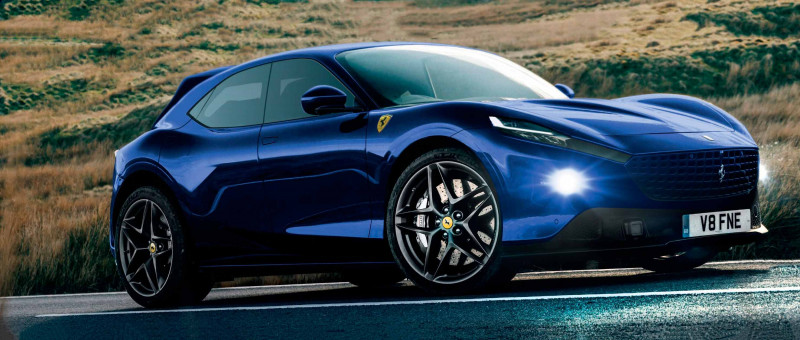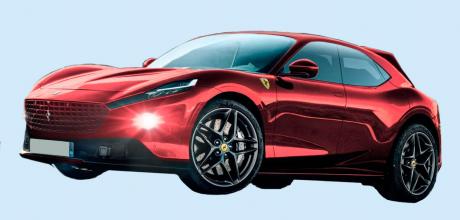2025 Ferrari Purosangue New ‘FUV’ to get supercar pace
Ferrari guns for Urus with potent GT-aping Purosangue Ferrari’s landmark SUV will arrive this year with supercar performance, four-wheel drive and new tech.
MEGA V6 HYBRID FOR 2022 Just don’t call it an SUV
THE KING OF THE ROAD
New Ferrari Purosangue. Shocked by this? An EV is coming in 2025
Ferrari is just months away from introducing one of the most important models it has yet produced, the Purosangue SUV, fresh off the back of an all-time record year for sales and with a new-look leadership team in place. The Italian supercar maker is in rude health as it prepares to unwrap its long-awaitedAston Martin DBX rival, having sold 11,155 cars worldwide last year – a 10.1% hike on pre-pandemic 2019 – for a 20.6% increase in pre-tax earnings compared with two years ago.

Using the Roma’s V8 should make for a 0-62mph time of about 4.0sec and a top speed north of 190mph
Recently appointed CEO Benedetto Vigna said the double-digit growth exceeded the firm’s own guidance and gives it “strong momentum” to “seize the opportunities ahead” – details of which are expected to be given as part of a long-term strategy announcement on 16 June. One of those opportunities will be capitalising on the meteoric surge in popularity of super-fast luxury SUVs in the vein of the Purosangue. The similarly conceived Lamborghini Urus, Bentley Bentayga, Porsche Cayenne and Aston Martin DBX have each become a mainstay of their manufacturer’s line-up, in some cases regularly outselling their more traditional sports car stablemates.
But Ferrari’s take on the formula will be overtly related – in terms of its technical make-up, design and positioning – to its sports cars. Its classic front-mid-engined proportions and squat, coupé-esque silhouette will make the Purosangue, claims its manufacturer, a ‘Ferrari utility vehicle’, rather than a conventional SUV.
Recent spy shots showing the Purosangue in its production bodywork suggest there will be a concerted effort to link the new arrival stylistically with the Roma grand tourer (which will be a close technical relation) with a low, sweeping bonnet, heavily raked glasshouse and swollen haunches.
The Purosangue is able to maintain a near-traditional GT-aping silhouette mostly because of its use of a new front-mid-engined architecture that positions the engine further back in the chassis, behind the front axle, for optimum weight distribution and a low centre of gravity.
This platform – one of two that will underpin future Ferrari models – can be configured to accommodate two- and four-wheel-drive layouts, different wheelbase sizes and both hybrid and pure-combustion models. It can also house V6, V8 and V12 engines – although Ferrari is not disclosing the technical specifications of the Purosangue until the full reveal later this year.
Among the likely powertrain options for the Purosangue is the 3.9-litre twin-turbo V8 as featured in the Roma. With 621bhp and 561lb ft, it is closely matched in terms of outright potency to the engines used in the Purosangue’s primary rivals and should make for a 0-62mph time of around 4.0sec and a top speed north of 190mph. The new SUV is also set to become Ferrari’s fourth production hybrid model, likely with a variation of the all-new electrified V6 that is making its debut in the 296 GTB. Whether it will match the supercar’s 819bhp output remains to be seen, but the 164bhp EV motor sited ahead of the rear-mounted gearbox is expected to feature. The longer wheelbase could give scope for Ferrari to increase battery capacity beyond 7.45kWh for an electric-only range of more than 16 miles.
A V12 option is also on the cards and could provide the basis for a more luxury-focused variant to rival the Bentley Bentayga Speed and Rolls-Royce Cullinan, in line with Ferrari’s ongoing commitment to its largest engine. But given that the new V6’s distinctive engine note and 8500rpm redline have prompted Ferrari to nickname it “the little V12”, it is unclear whether both will feature in the Purosangue line-up.
The Purosangue is also expected to play a key role in advancing Ferrari’s in-car technology offering, a product of the computing and technology backgrounds of the new team charged with launching it and the partnerships Ferrari has forged in recent months. Vigna is a veteran of the electronics industry, having spent 27 years at semiconductor manufacturer STMicroelectronics. Ferrari said that his experience (predominantly in the connectivity, imaging and power solution sectors) will accelerate the firm’s ability to pioneer the application of next-generation technologies.
Vigna’s expertise – and that of his STMicroelectronics colleagues Ernesto Lasalandra and Angelo Pesci, who have joined as R&D boss and head of quality and purchasing respectively – will no doubt help the supercar manufacturer integrate new interfaces, connectivity functions and driver aids. The brand’s new ‘hands on the wheel, eyes on the road’ approach to cabin design – as pioneered by the Roma and SF90 – aims to minimise distractions and boost driver appeal with the use of a comprehensive infotainment platform and steering wheel-mounted controls for all core functions.
Using the Roma’s V8 should make for a 0-62mph time of about 4.0sec and a top speed north of 190mph
Behind that nose is an engine mounted aft of the front axle. Raised ride height is apparent, despite the mule’s disguise. New platform enables a rakish, GT-style side profile.
WHAT ABOUT A ‘PURO-EV’?
Ferrari’s first pure-electric car will arrive in 2025 and company chairman John Elkann has promised it will be “everything you dream the engineers and designers at Maranello can imagine for such a landmark in our history”.
Whether or not the Purosangue will provide the basis for the debut EV remains to be confirmed, but our most detailed clues so far come from patent filings (pictured) that reveal Ferrari is developing a four-wheel-drive layout with a motor on each wheel and batteries distributed throughout the chassis, which could be the key to maintaining equal weight distribution and promoting keen dynamics.
Ferrari’s take on the SUV formula is closely related to its sports cars
New CEO Benedetto Vigna


